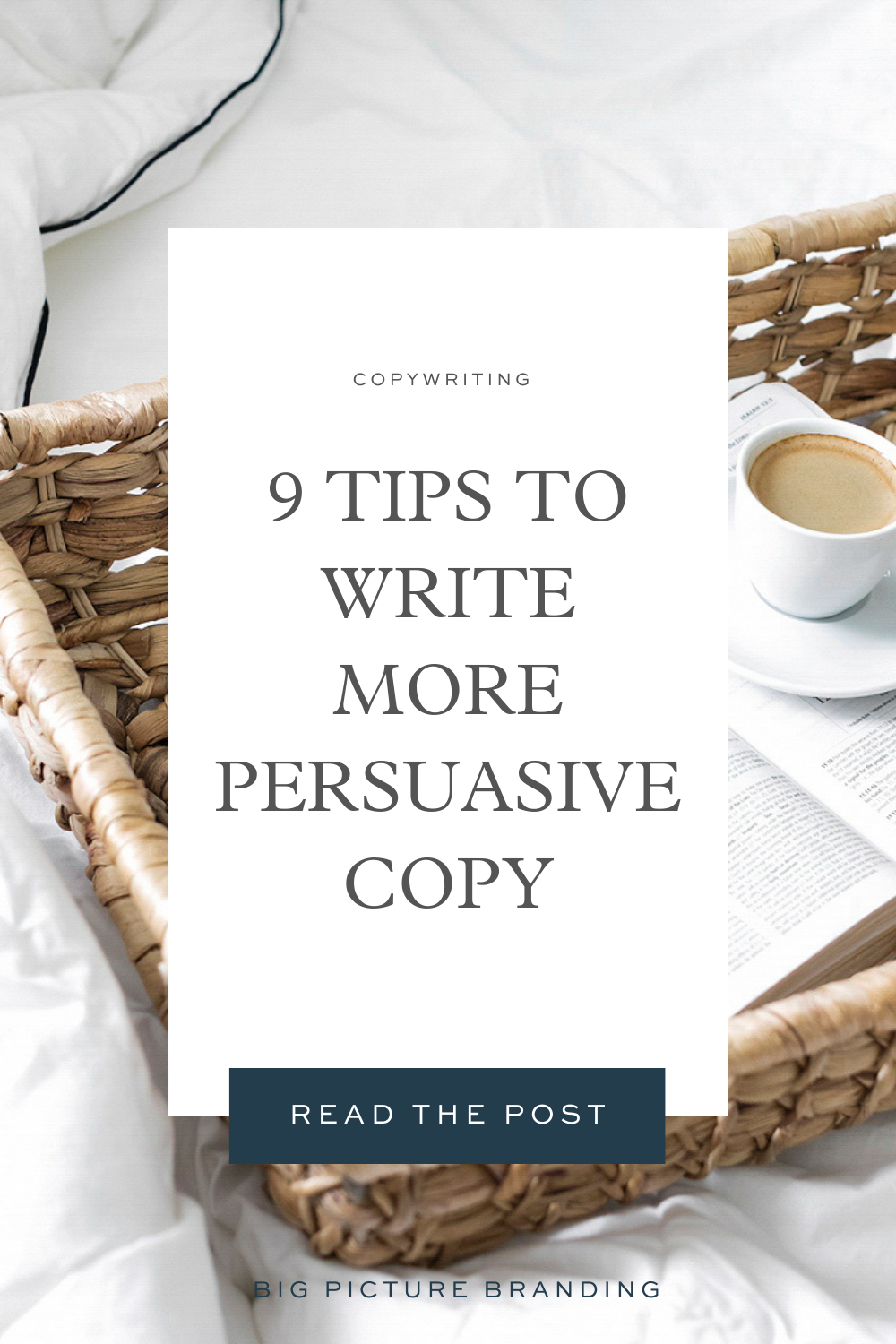I’m going to come right out and admit that the general reaction to the term “Persuasion Copywriting” is…not great. We are (states the obvious) inundated with marketing messages and thanks to many think-pieces and documentaries, we have become increasingly aware of the manipulation tactics used to get us to consume more, more, more.
More content, more engagement, and more chances to learn your preferences so the perfect relaxed linen pant shows up in your feed right before you head off on your summer holiday. (I might be speaking from experience.)
So yeah, “persuasion” kind of seems like a dirty word.
But let me reframe how I use persuasive copywriting techniques to write clear, informative, and contextual copy so my client’s audience can make an informed decision about whether or not a course, service, or digital product will meet their needs, and is worth the investment.
What is Persuasion Copywriting?
In my practice, persuasion copywriting is not about convincing someone to buy something they don’t need or weren’t looking for in the first place. Persuasion copywriting is about standing out and creating a more compelling case than your competition.
It’s about using all the tools in your toolkit to make your copy effective.
If someone Googles “Copywriting Course” and lands on the sales or product page for The Copywriting Cohort Course, my goal should be to persuasively communicate what the course is about and supply them with a couple of different angles to evaluate whether or not it’s a good fit.
After all, you don’t want your students or clients to sign up, become discouraged, leave a bad review, or request a refund. Persuasion copywriting that leaves you catfished or misinformed is unethical and bad for business.
So, what are a few ethical sales copywriting techniques you can use to inform and engage your audience?
How To Write Persuasive Copy
1) Storytelling
Telling a story makes your copy memorable and meaningful. But unless you’re a natural-born writer, this tip is easier said than done.
Here’s a great hack: Create a mental movie and be specific with your descriptions. It helps to consider what your reader recently experienced that led them to your site.
Here’s an example from the Copywriting Cohort Course sales page:
“You don’t need another self-paced copywriting course you’ll abandon after Module 2…”
Sure, the boatload of free templates sounded like a steal, but the truth is, those pretty little PDFs are still sitting in your downloads folder collecting digital dust.
(Or, if you’re like me, you have a folder on your desktop called “Freebies” and it’s not worth the amount of RAM storage it’s taking up.)
When you’re a DIY-er on a budget, you’re all about using templates and frameworks to guide your copywriting but…
Dang, it would be nice to have someone else’s eyeballs to check your work!
Your reader just heard their inner dialogue unfold on the big screen.
Storytelling is especially effective on About pages (See: How to write your About page, 5 Ground rules for telling your brand story, and How to write your brand story). Just remember to address “what’s in it for me?” Don’t get so caught up in the “you” part of the story that you forget to tell your readers how you’re going to help them solve their problems.
2) Sell On Emotion, Justify With Logic
As buyers, we tend to make an emotional decision first, then look for reasons to justify our purchase. (Especially if you are the Socializer Buyer Type.) This is why all good sales or services pages will include a bulleted list of features and benefits immediately after the storytelling intro or section of the page.
This, of course, begs the question: What’s the difference between benefits and features?
Features are the tangible goods the client gains access to or walks away with (workbooks, private community, frameworks, tools, a finished website, a logo, etc.) Benefits describe why those deliverables or your services matter to your client.
For example, we recently purchased a new security system for our home. We got all the equipment (features) needed to monitor our windows and doors like smart locks, motion sensors, and 24/7 monitoring protection. The benefit of this particular company is no drilling or installation tools were needed and (here’s the big one) our new security system makes us feel safe and puts us at ease when we’re traveling or away from home.
In the end, we buy something because of the promised benefit to our lives. The deliverables show us how we’ll get there.
If you want to really nail the emotional hook, tap into your reader’s existing emotions, and not just the obvious ones. If you need help uncovering what’s going on in the back of their mind:
Check out my Audience Research Checklist for the best places and ways to research your audience online.
3) Appeal to Maslow’s Hierarchy of Needs
At the end of the day, our behaviors are motivated by our most basic needs:
-
Physiological needs (food, water, warmth, rest)
-
Safety needs (security, safety)
-
Belonging (relationships, community)
-
Self-esteem (prestige, feelings of accomplishment)
-
Self-actualization (achieving your potential, self-fulfillment)
Sweep through your copy and ask yourself if you’ve touched on how your product or service can fulfill each need.
4) Speak your buyer’s language
You’ve probably heard “write like you speak” as a way of thinking about writing with personality. Maybe the way you speak and the way your audience speaks does not differ, but reframing can be especially helpful when you’re writing a sales or service page that speaks directly to your reader.
You want your reader to feel like you are reading their mind. Use phrases, slang, and nods to the cultural zeitgeist of the day to build a connection with them.
When your buyer feels like “we could def be friends” they are more likely to trust you and your expertise. (It’s on you to deliver on this promise!)
5) Leverage Authority
I know, I know, you get all awkward when you have to talk about yourself but trust me, your prospects are looking for indicators that you’ve got the experience and know-how to help them solve their problems. The good news is, that leveraging your authority doesn’t mean including a copy of your CV on your site and you don’t have to be the one shouting here ye! here ye! in the town square.
Get down off your soapbox and let others do the selling for you via “social proof”.
Types of social proof:
-
Client testimonials
-
Customer Reviews (Target lets customers post OOTD photos along with their reviews.)
-
Case studies / portfolio graphics
-
Logo banners (clients you’ve worked with, media you’ve done, training badges, etc.)
-
Video clips of conference talks or workshop topics you’ve done
Social proof tip: Include photos of your clients and customers whenever you can. (With their permission.) Humans are hard-wired to respond to human faces. Not only that, it builds the trust factor and engages our natural desire to want to fit in and be a part of a community of like-minded individuals. Photos can also signal when someone doesn’t fit a particular mold – most commonly race, gender, social class, and industry. This is something every business should be aware of so you’re not inadvertently sending the wrong visual message.
6) Use Humor
The golden rule of using humor in your writing is to favor clear over clever, always. Humor is highly-subjective and tone can be hard to infer in written form. (Everyone who has ever texted with a parent should be nodding their head in agreement.)
Done well, humor can disarm your audience, help you connect, and bring a little energy and personality to your writing. However, you shouldn’t try to be funny if you’re not naturally a funny person. Forcing humor risks coming off as inauthentic or trying too hard, and it might not be entirely appropriate for your industry or subject matter.
…I will note, that I’ve had a client who was an end-of-life planner, and her whole brand centered around reframing death so it wasn’t a taboo issue people avoided preparing for before it was too late…literally. Her content was uplifting and poked fun at the ridiculous ways we talk (or don’t) about death. Her brand imagery included a cartoon grim reaper. That was funny and proved a point central to her messaging.
7) Price Framing or Price Anchoring
Price anchoring is where you break down the value of your offer into calculatable parts or give the investment more context.
For example: “The Marketing Receipt”
Here’s what’s included in the Post-Purchase Email Sequence Template Pack:
-
Email #1 Purchase Delivery & Cross-Selling Hero (Valued at $250)
-
Email #2 Feedback Finder (Valued at $250)
-
Email #3 Last Chance Love Note (Valued at $250)
-
Subject line suggestions (Valued at $25)
-
Footer and return policy language (Valued at $25)
-
Cross-sell imagery ideas (Valued at $20)
-
Quickie Brand Voice Primer (Valued at $50)Total: $870* $35
*Pssst: That’s $835 less than the cost of hiring a professional copywriter.
“The Starbucks Test”
Get unlimited analytics and customer service support for less than the cost of your daily iced espresso con crema.
Price is the most subjective way we assign value to goods and services. Plus, we have all sorts of hangups when it comes to evaluating worth. Putting the price into context helps frame how much value something holds and helps shake any preconceived notions about what you estimate something to cost, in the back of your mind.
8) Use Power Words
Power words are specific words that invoke an immediate response from a reader. It might invoke curiosity or summon an emotion or reveal something about the product or service that influences whether or not you decide to purchase.
Power words may not be poetry, but they can transform boring writing into compelling copy and inject your headlines with the kind of energy that keeps your readers engaged and scrolling down the page.
For example:
Inspire your team to take action.
-VS-
Galvanize your team to take action.
You can use power words anywhere, but they really shine when they’re used in shorter copy elements.
Learn how and where to use power words for maximum effect and grab 100+ Power Words To Boost Conversions (Downloadable Swipe File)
9) Tackle Objections
The thing about objections is they tend to hang out in the back of our minds, rather than waving obvious “do not pass go” signs. Objections can be subconscious – the little voice that tells us to walk away from an opportunity. Often it’s not because a service or product is bad, we just don’t have enough information to feel confident enough to make a choice.
For buyer types like The Thinker, buyer’s remorse is their #1 fear. It’s your job to help de-risk a purchase decision by supplying as much information as possible.
-
Offer a money-back guarantee
-
Offer a generous return window or try-before-you-buy
-
List out frequently asked questions and answer them in a friendly, conversational tone.
-
Provide lots of social proof
-
Use price framing (See #8 above)
Conclusion
Writing persuasive copy comes down to making a clear and compelling case for why your goods or services are the right fit for your audience. Your job is to make it easy for your readers to evaluate what they’re looking at and feel good, even excited, about their purchase decision. Persuasion copywriting tactics are not about convincing someone to purchase something they don’t want or need, they’re simply strategies for keeping your writing relevant and engaging.
PIN IT TO SAVE FOR LATER

